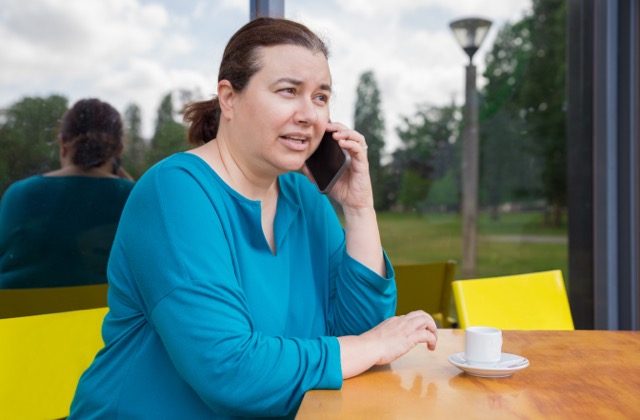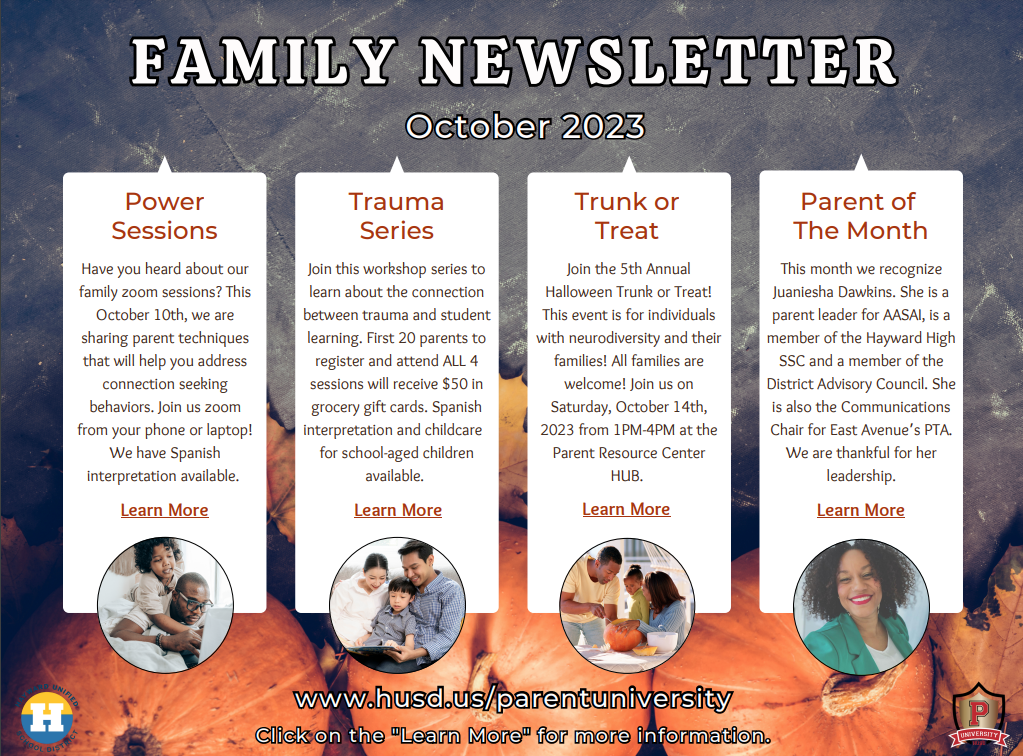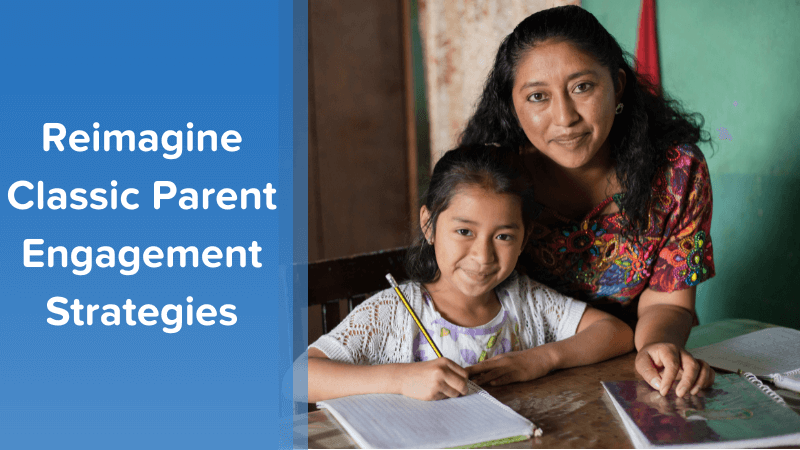By Maren Madalyn, contributing writer
It’s no secret that the COVID-19 pandemic flipped the education world upside down when it shuttered schools and learning institutions across the country in 2020. Even now in this semi-normal state we’ve returned to, there’s a palpable difference in what students, educators, and families are all experiencing. From an ongoing teacher shortage across multiple states to slow academic recovery, these challenges can feel intimidating for educators to navigate.
But even here, there are silver linings and positive trends that this collective experience actually catalyzed — especially trends in family engagement strategies that were shifting even before the pandemic struck.
And that’s a good thing!
As ParentPowered weathered the storm alongside our partners in K-12 school districts, early learning programs, and community-based organizations, we witnessed educators’ creative and powerful shifts to classic parent engagement strategies that ultimately better serve these partnerships today.
We compiled a list of the most common ways schools and districts promote positive parent engagement — and how your team, too, can reimagine them for the benefit of the entire learning community!
Why parent engagement outshines involvement
As educators continue to learn about effective family-school partnership examples and approaches, it is important to understand how engagement differs from involvement, and why this difference matters.
Involvement: creating space for parents to participate
Research has long shown that parental involvement in student learning has positive correlations with a wide variety of educational outcomes, especially academic success. Strategies that emphasize parent involvement often center around activities happening on campus — which makes sense on the surface. Students are spending a lot of time learning in classrooms, on the playground, or in after-school activities that typically happen on school grounds. So, naturally, schools seek to bring parents into these spaces as a means to welcome them into the learning environment and encourage their engagement in schools.
That’s part of the challenge.
For starters, several barriers can affect a parents’ capacity to participate in school-centered events. For instance, to attend an on-site event like a family workshop, some families might have to pay for a sitter, take time off work, or travel from work to make it. Yes, there are parents who can afford these incremental costs or have flexibility in their schedule — but many families likely cannot navigate these barriers.

Another challenge with family involvement is that, sometimes, educators can hold the same expectations for what involvement looks like for all families, regardless of each family’ unique background, circumstances, or past experiences with school. But in reality, every parent comes to a school community with their own perspective, hopes, fears, and dreams for their child’s learning. Each of these experiences can affect how and when a parent believes they can or should participate. This is just one of several common assumptions about family engagement in education that educators are detangling and reimagining as they shift to supporting families with greater success.
Engagement: elevating parents from participants to partners
These challenges don’t necessarily negate the value of parent involvement in education — any amount of participation in their child’s learning imparts benefits for students and schools! But what’s even more impactful is equitable family engagement. When educators incorporate families as essential players on the education team, they set up each child to thrive, be it in academics, social-emotional learning, or even physical health.
As an example, if involvement looks like inviting parents to attend Back-to-School Night on campus, then engagement takes this activity to the next level by going virtual for families who cannot attend in person. This ensures the entire community can access the valuable information shared during the event. Better still, a school might recruit parents to help facilitate special workshops or learning stations during Back-to-School Night alongside teachers and school staff.
Dr. Karen Mapp of the Harvard Graduate School of Education shaped her own research about effective family engagement into a framework for educators to follow as they strategies building strong relationships with their families. According to the Dual Capacity-Building Framework, the most effective examples of family engagement in schools are:
- Relational, built on mutual trust
- Directly linked to learning and development
- Strengths-based, focusing on assets over gaps
- Culturally responsive and respectful
- Interactive and collaborative
When educators invest time and energy into reimagining their family engagement methods, they reap a bounty that nourishes everything from increased graduation rates to higher academic achievement to improved student mental health. The positive impact of family-school partnerships is well worth it!
“Involved parents take part in the activities already determined by the school. Engaged parents take a step further, often becoming part of the school’s decision-making process.”
Annie Casey Foundation
6 classic parent engagement strategies, reimagined
With this clear understanding of why family and community engagement in schools matters — let’s take these six classic parental engagement strategies used by many learning organizations. Discover how your colleagues around the country are reimagining them in whole new ways.
Looking for a partner in equitable family engagement? ParentPowered is here to help. Join an upcoming info session to learn why educators love our family engagement curricula, which deliver evidence-based learning activities to families weekly via text message.
The parent-teacher conference
It’s tough to find a school that doesn’t employ some form of parent-teacher conference — a gathering in which educators meet with the families of each student they serve. These meetings occur about once or twice per year and are often brief, lasting around 15-30 minutes on average. The goal is for everyone to have a shared understanding of where kids are performing well and where they can continue to grow.
In the past, these conferences may have been one of the few touchpoints between home and school about student growth and development. This form of parent-teacher communication may also have emphasized the teacher, as an expert in learning and instruction, imparting knowledge to families about their child.
But parents are also experts — on their children! There is ample opportunity for educators to reimagine the parent-teacher conference as one of a variety of tools for information exchange, collaboration, and trust-building between home and school.

Here are a few ways to revitalize your parent-teacher conferences and help your staff open the door to building a positive relationship with each of their students’ families:
- Let parents lead the conversation. Start each conference by offering space to parents to ask questions, share what they want to understand or learn more about their child’s schooling, and any concerns or hopes they have for their student. You can weave in critical information about that student’s classroom experiences as relates to these questions, while also ensuring parents feel heard and like they’re part of the collaboration.
- Explore how communication can continue after the conference. Technology tools offer educators so many opportunities to keep the conversations with families going with parents, with minimal efforts on a teacher’s part. Research shows that when families receive even short messages at regular intervals from their school, it can boost student learning, even at the secondary level (Kraft & Rodgers, 2015). Find the digital tools that can support staff with maintaining a line of communication with parents after the conference concludes
- Meet with families out into the community. This strategy can be used across multiple channels of communication with schools and their families. Discover where your families gather beyond school walls — perhaps they are members of faith-based organizations, or frequently take advantage of a local library. Partner with these community groups to host events such as a teacher meet-and-greet at locations where families already gather and feel safe. Community organizations can be powerful allies in cultivating trust between families and their schools.
The family night on campus
Another popular way to involve families in student learning is the on-campus family night. It may come in various forms, like a family reading night or a parenting workshop, and these events create excellent opportunities for families to learn ways that they can support their children’s learning outside (and even inside) of the classroom environment. These workshops may also boost parents’ confidence in their own abilities and knowledge!
And — in the past, families who couldn’t attend these family nights live may have missed out entirely on the benefits these activities impact.
Technology has radically shifted what’s possible for school districts when it comes to supporting events like family night across their campuses. Virtual family workshops that became a staple for some schools during the pandemic continue to be an effective means to reach families across a community who may not be able to attend a live event. Other digital tools for family engagement, like ParentPowered’s text-based curricula, bring everyday learning opportunities to families directly — delivered right into their pockets, at no extra cost to parents.
Take a look at a few sample messages sent weekly to parents and see how family engagement can grow alongside kids and their families, from birth through high school.
The student take-home folder
Many of us can remember our own school take-home folders from elementary school, stuffed full of slips for parents to sign, reminders and announcements about upcoming school events, and examples of recent work we did in class. Whether these folders are physical or digital, they are a handy communication tool for teachers to send information out to families.
But what if these folders instead became the conduit for two-way communication between school and home — where families are sharing information with teachers just as often?
That’s exactly what Missy Martin asked herself as she and her family engagement team at Lexington 1 School District sought to revitalize their communication strategies with parents. Read our interview with Missy to learn how her team reshaped the classic take-home folder into an elevated communication tool and how teachers can make small but powerful shifts like this to cultivate parental engagement.
The school newsletter (or website)
Colorful, friendly, and fun — school newsletters are a great way to push general announcements and updates about what’s happening on campus to families, all in one place. I personally looked forward to reading school newsletters with my parents when I was in elementary school, hoping to see my classroom highlighted or my face in one of the photos.
But here again, information shared via school newsletters (or even the school website) can become one-directional — from school to home, fullstop. Fortunately, we can look to examples in the field for ways to reimagine using school newsletters to build reciprocal relationships with families.

Dekalb County School District, for instance, designed their parent and family engagement website to publish both regular school news and information about local resources, with direct links to access these organizations’ websites. Rio de Valle Middle School uses their principal’s annual letters to encourage families to submit feedback through a survey as part of their local accountability planning process. Hayward Unified School District celebrates members of its parent community with a monthly Parent of the Month column in its district newsletters.
Here are more suggestions for school leaders to explore as they craft school newsletters that nurture community engagement.
The school front office
The front office is often the first place a parent experiences when they arrive on a new campus for the very first time. It’s a critical hub that keeps schools running smoothly and a central location in which parents can get basic information they need about the school.
It’s also the perfect place to reimagine how schools can make a great first impression with families — setting the tone for their partnership right from the start!
In a recent panel interview, Jessica Webster of MAEC, Inc. and Rebecca Honig of ParentPowered offered helpful tips and tricks for educators for how to take advantage of the front office to create a positive, welcoming environment for families:
- Post signs in your families’ home languages. It is powerful for parents to see their native language reflected in their child’s learning environment, as it signals that this school welcomes their background and cultural identity. Practically speaking, translating signs also ensures families can get the help they may need, or at least indicate to school staff if they need a translator toward that end.
- Create a family resource wall. Connecting families with community resources is one of the most practical ways a school can nurture family wellbeing and in turn, their capacity to engage with student learning. Everyone deserves and needs to have their basic needs met, and a school front office can be the starting point to introduce families to local organizations, programs, and opportunities that can help. Collect pamphlets and other advertising materials from community partners in your area and make them readily available for parents to grab whenever they visit your school sites.
Want more insights into these and more habits of highly effective parental engagement? Read our blog post summarizing key takeaways or watch the full webinar!
The absence of family engagement at middle and high schools
Family engagement activities are often baked into the culture of younger grade levels. But when kids make the transition from elementary school into middle and high school, it’s not uncommon for schools and families to box their collaboration into less frequent intervals. For some schools, middle and high school family engagement may be limited to mere phone calls and emails — or otherwise, just pure myth.
But families are critical players on students’ learning teams no matter what age they are! Though the role of families certainly evolves as students get older, adolescent family engagement does exist, and it contributes as powerfully to positive learning environments in upper grade levels as it does in lower ones.
In fact, research studies have shown that when secondary school families are appropriately engaged and supportive of their students’ learning, kids are less likely to drop out of school and benefit academically (Jensen & Minke, 2017).

Here are just a few ways to reimagine family-school partnerships at the middle and high school levels, as shared by Edutopia:
- Partner with local businesses and organizations to bring school information into the community. Religious-affiliated locations, community centers, even local restaurants are excellent places that high schools can connect where families already gather. See if your school can set up a local bulletin board in these locations about upcoming school events or activities. You can also invite local business owners to support or even host student workshops about job readiness or career planning for high school students, leaning on their real-world perspectives and examples.
- Tap into parent leaders to cultivate an advocacy group. This is an especially handy approach to connect with families that speak different languages or represent different cultural groups within your school community. Identify parent leaders or members of these communities that may be interested in helping share information about school activities with other parents. Even hosting something as informal as a “Coffee Day with the Principal” can be a great way to build a relationship with families, through people they already know and trust.
Continuing the evolution of parent engagement
This list barely scratches the surface of what’s possible when school and district administrators reimagine their existing parent engagement activities and think outside the box. But at the core of all these ideations and evolutions is the philosophy that families and educators are on the same team, and that each has a critical role to play in supporting a student to grow and thrive.
ParentPowered is proud to support families at schools and districts across the country with creating everyday learning moments that evolve right alongside their kids. The best part? It’s easy for school administrators to implement with just a few clicks. Take a tour to discover the power of low-lift, high-impact family engagement curricula, available from birth through high school.
About the author
Maren Madalyn has worked at the intersection of K12 education and technology for over a decade, serving in roles ranging from counseling to customer success to product management. She blends this expertise with fluid writing and strategic problem-solving to help education organizations create thoughtful long-form content that empowers educators.












